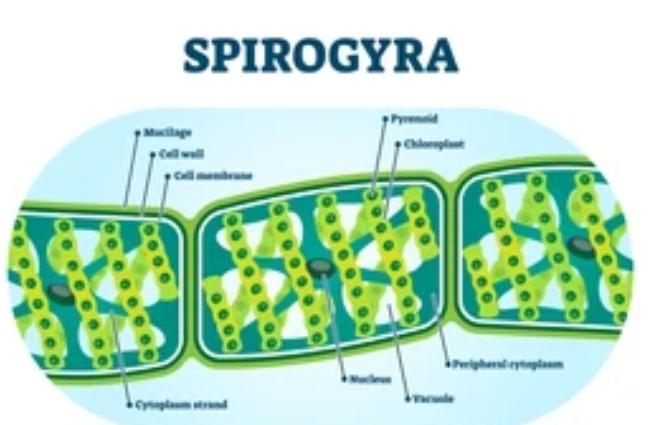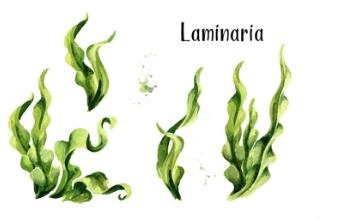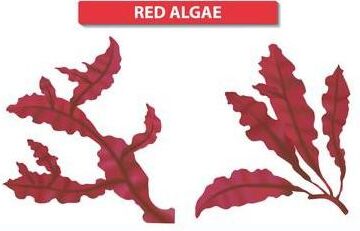Spirogyra is one of the most common and largest species, with about 300 species growing as floating colonies in stagnant or slow-moving water. Some species, eg
Spirogyra adnata is attached to the root by a basal root cell. The plant bundles are now slippery to the touch, because there are small membranes around the fibers that come into contact with the water, hence the name water silk or volcanic slime. Spirogyra blooms in the spring.
PLANT BODY
Spirogyra does not have branches with spherical cells connected by long green filaments. Individual cells are round, longer than wide. In the included species, there is no difference between basal and distal tips, but during ascent, the lower cells retain their root growth, which favors ascent.
Cell Structure
Cell wall
Every cell has a well-developed cell wall. The cell wall consists of two layers: the outer layer is made of cellulose and the inner layer is made of pectin.
Cytoplasm
Cytoplasm forms a thin layer between the cell wall and the large vacuole. Electron microscopy shows that mitochondria, endoplasmic reticulum, dictyosomes, and other cytoplasmic components are also present in the cells. The number of chromosomes varies from 5 to 24 in different species.
Nucleus
Each cell has a distinct central nucleus with thin strands of cytoplasm hanging from the cell wall.
Chloroplast
Chloroplasts are included in the peripheral cytoplasm and vary in number. Chloroplasts are ribbon-shaped and spirally arranged, forming a distinct and distinct green spiral on each tuft. Each chloroplast contains many pyrenoids, which look like small round bodies. Ingredients are chlorophyll a, b, c, d, carotene and xanthophylls.
Growth
Filament growth can only occur by cell division in every cell of the filament except the holdfast.
Reproduction
The reproduction in Spirogyra is vegetative and sexual mostly. However, some species exhibit asexual reproduction.
Vegetative Reproduction
During sexual reproduction, fission takes place and Spirogyra spontaneously enter mitosis to form new hyphae. There are no sex cells in this species.
Sexual Reproduction
Sexual reproduction occurs when it is not suitable for its development. This is an ancient form of sexual reproduction called conjugation.
Mechanism of Conjugation
In doing so, two fibers come close together and their sediments glue them together. Papillae grow from the outer cell walls. These papillae fuse together and their common walls separate to form a tubular structure called the conjugation tube. The protoplast of each cell bends through loss of water to form a gamete. Gametes are isogametes, but gametes are functional and pass from one lineage to another. This is called the male gamete. The new gamete is inactive and remains in the cell. This is called the female gamete. Spirogyra thus exhibits physiological anisogamy. All gametes in a conjugative filament can be male or female. The male gamete enters the female gamete through the conjugation tube.
The protoplast and nuclei of both gametes fuse to form a diploid zygote which secretes a thick wall to form a zygospore. After a resting period, the zygospore germinates into new filaments by cell division. Low nitrogen levels and high light intensity often stimulate sexual reproduction.
The conjugation may be scalariform conjugation or lateral conjugation:
- Scalariform conjugation
It is common in nature and is the result of the union of two parallel threads. All fibroblasts are able to produce angina pectoris. Each gamete produces a gamete. Cells destined to produce gametes form growth segments on both filaments that face each other and soon meet at their ends. The end wall is cleaned to form a continuous connection tube carrying two cells with different threads. This protoplasmic cell develops into an ovoid gamete.
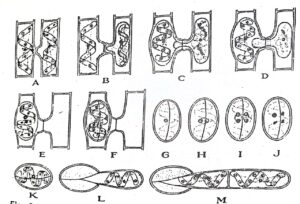
In fusion, after passing through the conjugation tube, one gamete reaches the opposite cell and fuses with the gametes of the other hyphae. This creates a zygospore in one cell and leaves the other cell empty. Based on the behavior, the motile cell is called male
The zygospore is usually formed in a cell from the filament and pair.
The leads are thus dioecious. In some cases, a zygospore is formed in a conjugation tube, in which case gametes move from both filaments. In such cases, the distinction between the sexes is impossible and they cannot be called male or female. The filaments in such cases are unicellular
In nature, most of the cells of the filaments participate in the process of sexual reproduction at the same time, causing both filaments to emerge from the epidermis, which is why they are called pacific or cutaneous conjugation.
- B) Lateral conjugation
It occurs between two adjacent cells that have the same filament, so these plants are bisexual and asexual. There are two types of lateral conjugations.
- I) the direct lateral conjugation
- ii) The in direct lateral conjugation.
- direct lateral conjugation
This interaction occurs between two adjacent cells, with the upper cell acting as the male gametophyte and the lower cell acting as the female gametophyte. The size of the lower cells increases. The protoplast of the male cell is always a smaller surface cell. A process that extends and interacts with the transverse wall between male and female cells. It later passes and forms a conjugation tube, which uses its contents to form a zygospore.

iil) Indirect lateral conjugation
It is rare and has been reported in S. affinis. In this process, the papillary growth of the transverse septum ruptures as it grows to form a posterior canal between the two cells. Of these, the top is a man’s game and the bottom is a woman’s. It is through this external process that the male gamut passes and joins the female gamut, forming a zygospore. Also called external link chain.
Chain conjugation
A complete conjugation tube can be formed between two adjacent cells to form a conjugation tube (S. collegate). Evidence for simultaneous endomorphic and lateral pairing in S. gratiana. Such a problem is very rare.
Zygospore
In either case, the zygote is the product of fusion which soon develops into a thick-walled zygospore. The zygospore is formed from the lysis of the gametophyte wall and settles. A period of rest passes. Before germination, the zygospore nucleus partially divides into four nuclei. Three of the four died, and only one survived. It germinates to form a haploid plant called the gametophyte
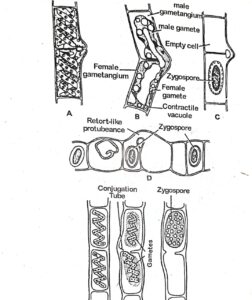
Parthenogenesis
In rare cases, gametes do not fuse, become spherical and do not remove the cell wall and act as spermatogonia. These germs are called spores. These spores germinate directly into new haploid plants.
Conclusion
In conclusion, Spirogyra is a remarkable genus of filamentous green algae with unique features in its structure and reproduction. The spiral-shaped chloroplasts, characteristic of Spirogyra, maximize the surface area for photosynthesis, enabling efficient light absorption and energy production. The filamentous structure composed of chain-like cells allows Spirogyra to thrive in various freshwater habitats, contributing to oxygen production and serving as an essential component of the aquatic food chain.
Regarding reproduction, Spirogyra employs both asexual and sexual methods. Asexual reproduction involves fragmentation, where individual cells break apart from the filament and grow into new individuals. Sexual reproduction occurs through conjugation, where two filaments come together, and specialized tubes facilitate the transfer of genetic material between cells. This process leads to the formation of zygospores, which are resistant structures that ensure survival during unfavorable conditions.
Spirogyra’s reproductive mechanisms contribute to maintaining genetic diversity within populations, helping to adapt to changing environmental conditions and promoting overall resilience. However, excessive pollution and unfavorable environmental factors can impact Spirogyra’s reproductive success, leading to consequences like algal blooms and disrupted ecosystems.
The study of Spirogyra’s structure and reproduction has provided valuable insights into the biology and ecological significance of green algae. Continued research on this intriguing organism may further our understanding of freshwater ecosystems and contribute to environmental conservation efforts.
Questions/Answers
1. Q: What is the general structure of Spirogyra?
A: Spirogyra is a filamentous green alga composed of long, thread-like chains of cells. Each cell contains a prominent central vacuole surrounded by a thin cytoplasmic layer, and a ribbon-like chloroplast with a unique spiral shape.
2. Q: How do the spiral chloroplasts in Spirogyra contribute to its survival?
A: The spiral chloroplasts in Spirogyra maximize the surface area available for photosynthesis. This adaptation allows the alga to efficiently capture sunlight and convert it into energy, supporting its growth and survival.
3. Q: Describe the process of reproduction in Spirogyra.
A: Spirogyra reproduces both sexually and asexually. In asexual reproduction, cells undergo fragmentation, where a filament breaks into smaller pieces, and each fragment can grow into a new individual. In sexual reproduction, two filaments come into close proximity, and specialized structures called conjugation tubes form to allow the transfer of genetic material between cells, leading to the formation of zygospores.
4. Q: What are zygospores in Spirogyra, and how are they formed?
A: Zygospores are the result of sexual reproduction in Spirogyra. They are thick-walled resting structures formed when two filaments of Spirogyra come together and their cells undergo fusion. The fusion forms a zygote, which then develops into a zygospore. Zygospores are resistant to adverse conditions and can survive until conditions become favorable for germination.
5. Q: How does Spirogyra maintain genetic diversity in its population?
A: Spirogyra maintains genetic diversity through sexual reproduction. During conjugation, genetic material is exchanged between two different filaments, leading to genetic recombination. This process ensures that each new zygospore has a unique combination of genetic traits, contributing to the overall genetic diversity within the population.
6. Q: What environmental factors influence the reproductive process in Spirogyra?
A: The reproductive process in Spirogyra is influenced by factors such as light availability, temperature, nutrient levels (especially nitrogen and phosphorus), and the presence of other organisms. These factors can affect the timing and success of both asexual and sexual reproduction in Spirogyra.
7. Q: Can Spirogyra reproduce in polluted water bodies?
A: Yes, Spirogyra can reproduce in polluted water bodies, but excessive pollution can negatively impact its growth and reproductive success. High levels of pollutants, especially nitrogen and phosphorus, can lead to algal blooms, causing overpopulation and depletion of oxygen in the water, which can be harmful to other aquatic life.

